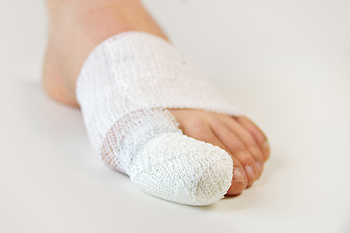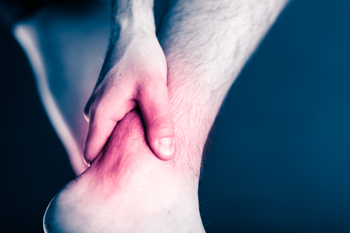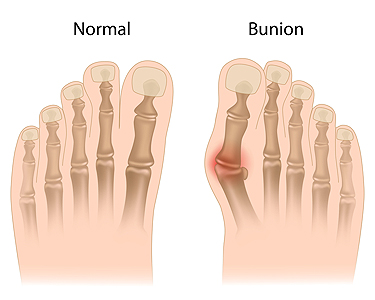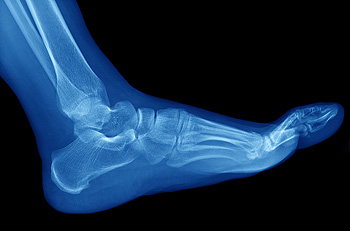 Flat feet refers to the absence of an arch in the middle of the sole of the foot. While some people are born with and continue to have flat feet for their entire lives, others acquire flat feet over time. As you age, your arches can slowly collapse and cause your feet to become flat. This can result in an uneven distribution of your body weight across the surface of your feet when you walk, which might then lead to pain in your feet, calves, knees, hips, and back. If your flat feet are causing you pain or discomfort, then treatment may be necessary. Common treatments for this condition include wearing orthotic devices or specialized footwear and doing foot stretches to strengthen the arch. If you are experiencing pain from flat feet, it is recommended that you seek the care of a podiatrist.
Flat feet refers to the absence of an arch in the middle of the sole of the foot. While some people are born with and continue to have flat feet for their entire lives, others acquire flat feet over time. As you age, your arches can slowly collapse and cause your feet to become flat. This can result in an uneven distribution of your body weight across the surface of your feet when you walk, which might then lead to pain in your feet, calves, knees, hips, and back. If your flat feet are causing you pain or discomfort, then treatment may be necessary. Common treatments for this condition include wearing orthotic devices or specialized footwear and doing foot stretches to strengthen the arch. If you are experiencing pain from flat feet, it is recommended that you seek the care of a podiatrist.
Flatfoot is a condition many people suffer from. If you have flat feet, contact one of our podiatrists from Lovely Foot Associates, PC. Our doctors will treat your foot and ankle needs.
What Are Flat Feet?
Flatfoot is a condition in which the arch of the foot is depressed and the sole of the foot is almost completely in contact with the ground. About 20-30% of the population generally has flat feet because their arches never formed during growth.
Conditions & Problems:
Having flat feet makes it difficult to run or walk because of the stress placed on the ankles.
Alignment – The general alignment of your legs can be disrupted, because the ankles move inward which can cause major discomfort.
Knees – If you have complications with your knees, flat feet can be a contributor to arthritis in that area.
Symptoms
Treatment
If you are experiencing pain and stress on the foot you may weaken the posterior tibial tendon, which runs around the inside of the ankle.
If you have any questions please feel free to contact our office located in Johnstown, PA . We offer the newest diagnostic and treatment technologies for all your foot and ankle needs.
 There are many signs that can indicate if a person has broken their toe. Common symptoms of a broken toe can include pain when the affected toe is touched, difficulty walking, as well as swelling and bruising. Bruising can appear with vivid discoloration if the injury is extreme. Sometimes the toenail of the affected toe can become severely damaged and show abnormalities if a break has occurred. Blood may become trapped under the toenail causing discoloration. More noticeably, you may see a bone protrude from the affected toe. If you believe you have a broken toe, it’s important that you visit a podiatrist who can provide a proper diagnosis and an advised treatment plan.
There are many signs that can indicate if a person has broken their toe. Common symptoms of a broken toe can include pain when the affected toe is touched, difficulty walking, as well as swelling and bruising. Bruising can appear with vivid discoloration if the injury is extreme. Sometimes the toenail of the affected toe can become severely damaged and show abnormalities if a break has occurred. Blood may become trapped under the toenail causing discoloration. More noticeably, you may see a bone protrude from the affected toe. If you believe you have a broken toe, it’s important that you visit a podiatrist who can provide a proper diagnosis and an advised treatment plan.
Broken toes may cause a lot of pain and should be treated as soon as possible. If you have any concerns about your feet, contact one of our podiatrists from Lovely Foot Associates, PC. Our doctors will treat your foot and ankle needs.
What Is a Broken Toe?
A broken toe occurs when one or more of the toe bones of the foot are broken after an injury. Injuries such as stubbing your toe or dropping a heavy object on it may cause a toe fracture.
Symptoms of a Broken Toe
Although the injured toe should be monitored daily, it is especially important to have a podiatrist look at your toe if you have severe symptoms. Some of these symptoms include worsening or new pain that is not relieved with medication, sores, redness, or open wounds near the toe.
If you have any questions, please feel free to contact our office located in Johnstown, PA . We offer the newest diagnostic and treatment technologies for all your foot care needs.
 Injury to the foot and ankle can be common among runners. Fortunately, there are steps you can take to help prevent injuries. It is said when you first start running, build up your training regimen slowly, increasing the amount of time and distance that you run at a very gradual pace. Allow your body and feet adequate time to adjust, as well as rest and heal. It is also important to develop a good running technique. This can be accomplished through running lessons, where an instructor can teach you about proper foot placement and other techniques to ensure that you stay safe while you run. Finally, make sure that you wear supportive, properly-fitted running shoes when you exercise. For more advice on preventing running injuries, consult with a podiatrist today.
Injury to the foot and ankle can be common among runners. Fortunately, there are steps you can take to help prevent injuries. It is said when you first start running, build up your training regimen slowly, increasing the amount of time and distance that you run at a very gradual pace. Allow your body and feet adequate time to adjust, as well as rest and heal. It is also important to develop a good running technique. This can be accomplished through running lessons, where an instructor can teach you about proper foot placement and other techniques to ensure that you stay safe while you run. Finally, make sure that you wear supportive, properly-fitted running shoes when you exercise. For more advice on preventing running injuries, consult with a podiatrist today.
Exercising your feet regularly with the proper foot wear is a great way to prevent injuries. If you have any concerns about your feet, contact one of our podiatrists of Lovely Foot Associates, PC. Our doctors will treat your foot and ankle needs.
How to Prevent Running Injuries
Many common running injuries are caused by overuse and overtraining. When the back of the kneecap starts wearing out and starts causing pain in your knee, this is commonly referred to as runner’s knee. Runner’s knee is a decrease in strength in your quadriceps and can occur if you’re not wearing properly fitted or supporting shoes. To prevent runner’s knee, focusing on hip strengthening is a good idea, as well as strengthening your quads to keep the kneecaps aligned.
What Are Some Causes of Running Injuries?
- One cause of a common running injury is called iliotibial band syndrome.
- Plantar fasciitis is also another common injury.
- Stress fractures can occur from overtraining, lack of calcium, or even your running style.
Best Ways to Prevent Running Injuries
- Wear footwear that fits properly and suits your running needs.
- Running shoes are the only protective gear that runners have to safeguard them from injury.
- Make a training schedule. Adding strengthening exercises as well as regular stretching can help keep you strong and limber and can lessen the possibility of injuries.
- Stretching keeps muscles limber; this will help you gain better flexibility.
If you have any questions please feel free to contact our office located in Johnstown, PA . We offer the newest diagnostic and treatment technologies for all your foot and ankle needs.
 Ankle pain can have a variety of causes. One of the most common causes of ankle pain is injury from physical activity. Sprains and fractures can occur while exercising, playing a sport, or even walking if the ankle is rolled, turned or twisted awkwardly. Another common cause of ankle pain is osteoarthritis. Osteoarthritis is the type of arthritis usually associated with aging and wears away the cartilage on the ends of your bones and leads to joint damage and pain. Wearing shoes with inadequate support or a poor fit, standing or walking for prolonged periods of time, exercising excessively, or being overweight can result in ankle pain as well. If you are experiencing persistent ankle pain, it is recommended that you consult with a podiatrist.
Ankle pain can have a variety of causes. One of the most common causes of ankle pain is injury from physical activity. Sprains and fractures can occur while exercising, playing a sport, or even walking if the ankle is rolled, turned or twisted awkwardly. Another common cause of ankle pain is osteoarthritis. Osteoarthritis is the type of arthritis usually associated with aging and wears away the cartilage on the ends of your bones and leads to joint damage and pain. Wearing shoes with inadequate support or a poor fit, standing or walking for prolonged periods of time, exercising excessively, or being overweight can result in ankle pain as well. If you are experiencing persistent ankle pain, it is recommended that you consult with a podiatrist.
Ankle pain can have many different causes and the pain may potentially be serious. If you have ankle pain, consult with one of our podiatrists from Lovely Foot Associates, PC. Our doctors will assess your condition and provide you with quality foot and ankle treatment.
Ankle pain is any condition that causes pain in the ankle. Due to the fact that the ankle consists of tendons, muscles, bones, and ligaments, ankle pain can come from a number of different conditions.
Causes
The most common causes of ankle pain include:
Symptoms
Symptoms of ankle injury vary based upon the condition. Pain may include general pain and discomfort, swelling, aching, redness, bruising, burning or stabbing sensations, and/or loss of sensation.
Diagnosis
Due to the wide variety of potential causes of ankle pain, podiatrists will utilize a number of different methods to properly diagnose ankle pain. This can include asking for personal and family medical histories and of any recent injuries. Further diagnosis may include sensation tests, a physical examination, and potentially x-rays or other imaging tests.
Treatment
Just as the range of causes varies widely, so do treatments. Some more common treatments are rest, ice packs, keeping pressure off the foot, orthotics and braces, medication for inflammation and pain, and surgery.
If you have any questions, please feel free to contact our office located in Johnstown, PA . We offer the newest diagnostic and treatment technologies for all your foot care needs.
 A bunion is a bony bump that forms on the joint at the base of the big toe or, occasionally, on the pinky toe. The bunion causes the affected toe to point towards the other toes, instead of pointing straight ahead. Bunions may be painful, making it difficult to walk, stand, wear your typical shoes, or do your usual daily activities. There are two main types of bunions, although many bunions can be a combination of both types. A positional bunion is caused by the joint enlarging as new bone grows. This stretches the outer covering of the joint and pushes the big toe towards the smaller ones, eventually pulling the big toe out of alignment. A structural bunion is caused by the angle between the bone of the big toe and second toe being larger than normal. This can also push the big toe towards the smaller toes. Regardless of the type of bunion you may have, it is recommended that you seek treatment from a podiatrist.
A bunion is a bony bump that forms on the joint at the base of the big toe or, occasionally, on the pinky toe. The bunion causes the affected toe to point towards the other toes, instead of pointing straight ahead. Bunions may be painful, making it difficult to walk, stand, wear your typical shoes, or do your usual daily activities. There are two main types of bunions, although many bunions can be a combination of both types. A positional bunion is caused by the joint enlarging as new bone grows. This stretches the outer covering of the joint and pushes the big toe towards the smaller ones, eventually pulling the big toe out of alignment. A structural bunion is caused by the angle between the bone of the big toe and second toe being larger than normal. This can also push the big toe towards the smaller toes. Regardless of the type of bunion you may have, it is recommended that you seek treatment from a podiatrist.
If you are suffering from bunions, contact one of our podiatrists of Lovely Foot Associates, PC. Our doctors can provide the care you need to keep you pain-free and on your feet.
What Is a Bunion?
A bunion is formed of swollen tissue or an enlargement of boney growth, usually located at the base joint of the toe that connects to the foot. The swelling occurs due to the bones in the big toe shifting inward, which impacts the other toes of the foot. This causes the area around the base of the big toe to become inflamed and painful.
Why Do Bunions Form?
Genetics – Susceptibility to bunions are often hereditary
Stress on the feet – Poorly fitted and uncomfortable footwear that places stress on feet, such as heels, can worsen existing bunions
How Are Bunions Diagnosed?
Doctors often perform two tests – blood tests and x-rays – when trying to diagnose bunions, especially in the early stages of development. Blood tests help determine if the foot pain is being caused by something else, such as arthritis, while x-rays provide a clear picture of your bone structure to your doctor.
How Are Bunions Treated?
If you have any questions, please feel free to contact our office located in Johnstown, PA . We offer the newest diagnostic and treatment technologies for all your foot care needs.
 The ankle-brachial index (ABI) is a quick and non-invasive form of vascular testing that your podiatrist may perform during a routine visit. It is frequently used to assess the presence or severity of peripheral artery disease, a potentially dangerous condition that results in poor circulation to the lower limbs. The ankle-brachial index test is performed in several steps. Similarly to typical checkups at your physician’s office, first, the doctor will measure your blood pressure around your upper arm. Then, the doctor will measure your blood pressure around your ankle. The two numbers are compared to find the ankle-brachial index value, a number that is used to determine the presence or severity of peripheral artery disease. The lower the ABI value is, the greater the chance that you have arterial disease. If you suspect you have poor circulation to your lower limbs, it is recommended that you visit a podiatrist, who can perform an ankle-brachial index test, as well as other vascular tests to assess blood flow to your feet and ankles.
The ankle-brachial index (ABI) is a quick and non-invasive form of vascular testing that your podiatrist may perform during a routine visit. It is frequently used to assess the presence or severity of peripheral artery disease, a potentially dangerous condition that results in poor circulation to the lower limbs. The ankle-brachial index test is performed in several steps. Similarly to typical checkups at your physician’s office, first, the doctor will measure your blood pressure around your upper arm. Then, the doctor will measure your blood pressure around your ankle. The two numbers are compared to find the ankle-brachial index value, a number that is used to determine the presence or severity of peripheral artery disease. The lower the ABI value is, the greater the chance that you have arterial disease. If you suspect you have poor circulation to your lower limbs, it is recommended that you visit a podiatrist, who can perform an ankle-brachial index test, as well as other vascular tests to assess blood flow to your feet and ankles.
Vascular testing plays an important part in diagnosing disease like peripheral artery disease. If you have symptoms of peripheral artery disease, or diabetes, consult with one of our podiatrists from Lovely Foot Associates, PC. Our doctors will assess your condition and provide you with quality foot and ankle treatment.
What Is Vascular Testing?
Vascular testing checks for how well blood circulation is in the veins and arteries. This is most often done to determine and treat a patient for peripheral artery disease (PAD), stroke, and aneurysms. Podiatrists utilize vascular testing when a patient has symptoms of PAD or if they believe they might. If a patient has diabetes, a podiatrist may determine a vascular test to be prudent to check for poor blood circulation.
How Is it Conducted?
Most forms of vascular testing are non-invasive. Podiatrists will first conduct a visual inspection for any wounds, discoloration, and any abnormal signs prior to a vascular test.
The most common tests include:
These tests are safe, painless, and easy to do. Once finished, the podiatrist can then provide a diagnosis and the best course for treatment.
If you have any questions, please feel free to contact our office located in Johnstown, PA . We offer the newest diagnostic and treatment technologies for all your foot care needs.
 People who enjoy yoga may be familiar with getting the occasional foot cramp during their practice. There are specific poses where the foot is tucked under and the top of the foot rests on the floor. Yoga poses are generally held for several minutes, which may cause foot pain. One of the reasons that pain in the feet may develop, can be a result of dehydration. This can be remedied by drinking plenty of water before, during, and after completing a yoga class. Foot stretches are important to perform before starting a yoga class. An effective stretch that can benefit the overall foot is done by rolling your ankles in both directions while lying on your back. This can be done while alternating pointing and flexing the feet. If you would like additional information on how to perform foot stretches during a yoga practice, it is suggested that you consult with a podiatrist.
People who enjoy yoga may be familiar with getting the occasional foot cramp during their practice. There are specific poses where the foot is tucked under and the top of the foot rests on the floor. Yoga poses are generally held for several minutes, which may cause foot pain. One of the reasons that pain in the feet may develop, can be a result of dehydration. This can be remedied by drinking plenty of water before, during, and after completing a yoga class. Foot stretches are important to perform before starting a yoga class. An effective stretch that can benefit the overall foot is done by rolling your ankles in both directions while lying on your back. This can be done while alternating pointing and flexing the feet. If you would like additional information on how to perform foot stretches during a yoga practice, it is suggested that you consult with a podiatrist.
Stretching the feet is a great way to prevent injuries. If you have any concerns with your feet consult with one of our podiatrists from Lovely Foot Associates, PC. Our doctors will assess your condition and provide you with quality foot and ankle treatment.
Stretching the Feet
Being the backbone of the body, the feet carry your entire weight and can easily become overexerted, causing cramps and pain. As with any body part, stretching your feet can serve many benefits. From increasing flexibility to even providing some pain relief, be sure to give your feet a stretch from time to time. This is especially important for athletes or anyone performing aerobic exercises, but anyone experiencing foot pain or is on their feet constantly should also engage in this practice.
Great ways to stretch your feet:
Individuals who tend to their feet by regular stretching every day should be able to minimize foot pain and prevent new problems from arising.
If you have any questions, please feel free to contact our office located in Johnstown, PA . We offer the newest diagnostic and treatment technologies for all your foot care needs.
Read more about How to Stretch Your Feet Arch pain is most commonly caused when the ligaments in the arch of the foot become strained or weakened. Arch pain may also occur after extended periods of walking or standing, or due to some muscles in the arch working harder than others. An example of this would be when one does not walk in a straight line. Wearing shoes with improper arch support, overusing the feet during sports, and being overweight can also lead to stress and eventual pain in the arches of the feet. If you are experiencing pain in the arches of your feet, it is important to maintain a proper weight and wear proper footwear. If these issues persist, you may need to consult with a podiatrist to discuss what options could work to alleviate the pain.
Arch pain is most commonly caused when the ligaments in the arch of the foot become strained or weakened. Arch pain may also occur after extended periods of walking or standing, or due to some muscles in the arch working harder than others. An example of this would be when one does not walk in a straight line. Wearing shoes with improper arch support, overusing the feet during sports, and being overweight can also lead to stress and eventual pain in the arches of the feet. If you are experiencing pain in the arches of your feet, it is important to maintain a proper weight and wear proper footwear. If these issues persist, you may need to consult with a podiatrist to discuss what options could work to alleviate the pain.
Foot Pain
Foot pain can be extremely painful and debilitating. If you have a foot pain, consult with one of our podiatrists from Lovely Foot Associates, PC. Our doctors will assess your condition and provide you with quality foot and ankle treatment.
Causes
Foot pain is a very broad condition that could be caused by one or more ailments. The most common include:
Diagnosis
To figure out the cause of foot pain, podiatrists utilize several different methods. This can range from simple visual inspections and sensation tests to X-rays and MRI scans. Prior medical history, family medical history, and any recent physical traumatic events will all be taken into consideration for a proper diagnosis.
Treatment
Treatment depends upon the cause of the foot pain. Whether it is resting, staying off the foot, or having surgery; podiatrists have a number of treatment options available for foot pain.
If you have any questions, please feel free to contact our office located in Johnstown, PA . We offer the newest diagnostic and treatment technologies for all your foot care needs.
 The Achilles tendon, located at the back of the ankle, connects the calf muscle to the heel bone. When the tendon gets overstretched because of forceful jumping, pivoting, or sudden acceleration, the tendon can tear or rupture. Some signs of an Achilles tendon tear includes sudden pain in the calf or ankle, swelling in the back of the leg, a popping sensation, and difficulty walking. An Achilles tendon rupture is a very serious injury that will require the care of a podiatrist to prevent further damage. Treatments that a podiatrist may recommend can include a walking boot, or in severe cases, surgery. Physical therapy will likely be necessary to aid in the recovery process as well. If you are afflicted with an Achilles tendon injury, please consult with a podiatrist for the best treatment techniques that are correct for you.
The Achilles tendon, located at the back of the ankle, connects the calf muscle to the heel bone. When the tendon gets overstretched because of forceful jumping, pivoting, or sudden acceleration, the tendon can tear or rupture. Some signs of an Achilles tendon tear includes sudden pain in the calf or ankle, swelling in the back of the leg, a popping sensation, and difficulty walking. An Achilles tendon rupture is a very serious injury that will require the care of a podiatrist to prevent further damage. Treatments that a podiatrist may recommend can include a walking boot, or in severe cases, surgery. Physical therapy will likely be necessary to aid in the recovery process as well. If you are afflicted with an Achilles tendon injury, please consult with a podiatrist for the best treatment techniques that are correct for you.
Achilles tendon injuries need immediate attention to avoid future complications. If you have any concerns, contact one of our podiatrists of Lovely Foot Associates, PC. Our doctors can provide the care you need to keep you pain-free and on your feet.
What Is the Achilles Tendon?
The Achilles tendon is a tendon that connects the lower leg muscles and calf to the heel of the foot. It is the strongest tendon in the human body and is essential for making movement possible. Because this tendon is such an integral part of the body, any injuries to it can create immense difficulties and should immediately be presented to a doctor.
What Are the Symptoms of an Achilles Tendon Injury?
There are various types of injuries that can affect the Achilles tendon. The two most common injuries are Achilles tendinitis and ruptures of the tendon.
Achilles Tendinitis Symptoms
Rupture Symptoms
Treatment and Prevention
Achilles tendon injuries are diagnosed by a thorough physical evaluation, which can include an MRI. Treatment involves rest, physical therapy, and in some cases, surgery. However, various preventative measures can be taken to avoid these injuries, such as:
If you have any questions please feel free to contact our office located in Johnstown, PA . We offer the newest diagnostic tools and technology to treat your foot and ankle needs.